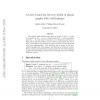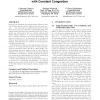320 search results - page 26 / 64 » Parity Problems in Planar Graphs |
NETWORKS
2011
12 years 10 months ago
2011
A graph is terminal ∆ − Y -reducible if, it can be reduced to a distinguished set of terminal vertices by a sequence of series-parallel reductions and ∆−Y -transformations...
STOC
1998
ACM
14 years 1 hour ago
1998
ACM
We introduce and study a modi ed notion of planarity, in which two regions of a map are considered adjacent when they share any point of their boundaries
not an edge, as standard...
CORR
2010
Springer
13 years 7 months ago
2010
Springer
The disjoint paths problem asks, given an graph G and k + 1 pairs of terminals (s0, t0), . . . , (sk, tk), whether there are k + 1 pairwise disjoint paths P0, . . . , Pk, such tha...
GD
2009
Springer
14 years 11 days ago
2009
Springer
In this paper, we explore a new convention for drawing graphs, the (Manhattan-) geodesic drawing convention. It requires that edges are drawn as interior-disjoint monotone chains o...
STOC
2006
ACM
14 years 8 months ago
2006
ACM
We study the maximum edge-disjoint paths problem in undirected planar graphs: given a graph G and node pairs s1t1, s2t2, . . ., sktk, the goal is to maximize the number of pairs t...


